|
Thursday, Oct. 18
11 a.m.
Academic Lecture Series - Curia II
Speaker: B. Dobrescu, Fermilab
Title: Physics in Extra Dimensions - Part 2
1 p.m.
ILC ALCPG Physics and Detector R&D Seminar - West Wing, WH-10NW
Speaker: R. Cassell, Stanford Linear Accelerator Center
Title: Analyzing SiD PFAs: A Path for Improvement
2:30 p.m.
Theoretical Physics Seminar - Curia II
Speaker: D. Forde, Stanford Linear Accelerator Center and University of California, Los Angeles
Title: On-Shell Methods for One-Loop Amplitude Calculations
3:30 p.m.
DIRECTOR'S COFFEE BREAK - 2nd Flr X-Over
THERE WILL BE NO ACCELERATOR PHYSICS AND TECHNOLOGY SEMINAR TODAY
Friday, Oct. 19
3:30 p.m.
DIRECTOR'S COFFEE BREAK - 2nd Flr X-Over
4 p.m.
Joint Experimental-Theoretical Physics Seminar - One West
Speaker: D. Tsybychev, State University of New York, Stony Brook
Title: Looking for New Physics in the B-Quark System
8 p.m.
Fermilab International Film Society - Auditorium
Tickets: Adults $5
Title: Donnie Darko
Saturday, Oct. 20
8 p.m.
Fermilab Arts Series - Auditorium
Tickets: $16/$8
The Tweaksters
Click here for NALCAL,
a weekly calendar with links to additional information.
|
Thursday, Oct. 18
- Minnesota wild rice w/chicken
- Tuna melt on nine grain
- BBQ ribs
- Chicken casserole
- Buffalo chicken wrap
- Assorted slice pizza
- Toasted pecan chicken salad
*Carb restricted alternative
Wilson Hall Cafe menu |
|
Thursday, Oct. 18
Dinner
- Mussels in saffron sauce
- Duck w/pinot noir sauce
- Moroccan sweet potato stew
- Bittersweet chocolate Irish whiskey cake
Wednesday, Oct. 24
Lunch
Closed
Chez Leon menu
Call x4598 to make your reservation. |
|
|
Fermilab musicians ready to rock Science in Art exhibit
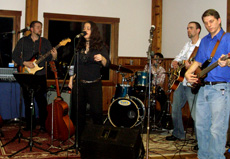
A mix of music from a group of Fermilab employees will play at opening night of UChicago's Science in Art exhibit. Pictured left to right: Daren Plant, AD; Elisa Rodriguez, formerly an operator in the Main Control Room; Justin O'Connell (not from Fermilab); Michael Backfish, AD; and Derek Plant, AD. Not pictured: Duncan Brown, DZero.
Music by a group of Fermilab employees will set the tone for the University of Chicago's Science in Art exhibit next weekend.
To give voice to the synergy of science and art, AD employees Michael Backfish, Daren and Derek Plant and DZero's Duncan Brown joined with former Fermilab employee Elisa Rodriguez and friend Justin O'Connell to compile a 30-minute CD of various music styles. The music will play while exhibit goers peruse more than 60 pieces of art created by scientists from University of Chicago science divisions and Argonne National Laboratory.
Music and art fit naturally with science and scientists, Backfish said. Backfish sees a connection between the creativity that inspires music and the creativity that sparks scientific discovery. "When you write music, you are creating something from nothing. It's just like the idea to chase a new experiment. We feed off of each other as we play, and once everyone gets going, songs inevitably come from that creative process," he said.
Backfish describes the CD as a melding of styles. His music has a "folky-rock feel" layer on top of "alternative country with roots in guitar rock." The Plant brothers' sound is "old-time blues music with finger-style guitar playing." Brown has "a British sound with good melodies." Rodriguez has an R&B-type voice. "She's got a lot of soul," Backfish added.
"When one of us writes a song and shares it with the group, you get everyone together and it becomes something entirely different," Backfish said. "Everyone brings something new to the table."
Music fans can visit the opening of Science in Art from 6 to 8 p.m. on Friday, Oct. 19, at the Center for Integrative Sciences at the University of Chicago. Music only plays during the opening.
The art exhibit runs through Nov. 16, but visitors should e-mail Becca Ayers or Lydia Bright to set up a time for a showing. Both the opening and the exhibit are free.
Preview a song from the CD.
(WAV file, 32 MB)
-- Haley Bridger
|
Open Grid Forum maintains focus on the 2010 goal
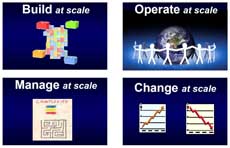
Grids are about scaling IT, and community organizations such as Open Grid Forum are essential to guiding and managing this growth process, said John Ehrig, Open Grid Forum enterprise and marketing program manager.
Images courtesy of Open Grid Forum.
Now involving more than 300 organizations from 50 countries, the Open Grid Forum community has gathered at this week's OGF21 to continue progress towards grids standards development.
Open Grid Forum Enterprise and Marketing Program Manager, John Ehrig, explained the goals and progress of this community-initiated not-for-profit organization.
Driven by accelerating globalization, organizations and individuals are being challenged to work in new ways-often across departments, disciplines and large geographical areas.
Read More
|
Probing question:
What is a neutrino?
From Physorg.com, Oct. 16, 2007
Neutrinos are tiny -- really, really tiny -- particles of matter. They are so small, in fact, that they pass between, and even through, atoms without interacting at all. Neutrinos are everywhere: If you start counting now, more than 10 quintillion (that's 10 trillion billions) of them will have passed through your body by the time you finish this article. Yet only one of those 10 quintillion neutrinos will likely interact with an atom in your body. The rest will go merrily on their way.
Staggering numbers of neutrinos constantly pass right through the earth and off into distant space. Detecting them carries the idea of searching for a needle in a haystack to ridiculous extremes. Fortunately for scientists, there are a lot of them to look for. Irina Mocioiu, assistant professor of physics at Penn State, studies evidence of the rare interactions between neutrinos and other, more accessible, subatomic particles, such as protons and electrons.
How does she know when an interaction is taking place? "Neutrinos carry no charge, so they cannot be observed directly," Mocioiu acknowledges. But each collision can cause a characteristic change in a proton or an electron and transfer some of the energy of the moving neutrino into the motion of these charged particles. "There are many ways to see charged particles in a detector," she explains.
Read more
|
Astrophysicist replaces supercomputer with eight PlayStation 3's
From Wired, Oct. 17, 2007
Suffering from its exorbitant price point and a dearth of titles, Sony's PlayStation 3 isn't exactly the most popular gaming platform on the block. But while the console flounders in the commercial space, the PS3 may be finding a new calling in the realm of science and research.
Right now, a cluster of eight interlinked PS3s is busy solving a celestial mystery involving gravitational waves and what happens when a super-massive black hole, about a million times the mass of our own sun, swallows up a star.
As the architect of this research, Dr. Gaurav Khanna is employing his so-called "gravity grid" of PS3s to help measure these theoretical gravity waves -- ripples in space-time that travel at the speed of light -- that Einstein's Theory of Relativity predicted would emerge when such an event takes place.
Read more
|
|
|
Mapping the top quark landscape
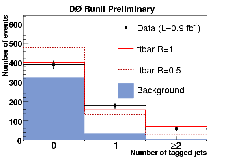
This figure shows the number of events with 0, 1, and 2 b-tagged jets in top-pair candidate events with a signature of one lepton and at least four jets. The contributions of the top-pair signal and backgrounds are shown along with a prediction how the signal would appear if the fraction of top->W+quark decays that include a bottom quark was R=1 (theory
prediction) or R=0.5.
Ask any physicist about top quarks and you'll hear that the top quark is big business at the Tevatron. This heavyweight particle guards many secrets about the universe, and its properties populate a complex landscape. Physicists at the DZero experiment have used their knowledge to create a clear and concise map of this terrain, helping to shed light on this particle's intricacies.
When Tevatron collisions produce top quarks, they generally come in pairs. According to theory, each top quark immediately decays to a W boson and a quark. This quark should nearly always be a bottom quark. Identifying it via b-tagging algorithms can isolate top quarks while reducing non-top backgrounds. Using events with b-tagged jets and features consistent with top-pair production, DZero physicists lay the cartographic groundwork for their map. By separating the top-decay landscape into a grid of 3 or 4 jets wherein 0, 1, or 2 of the jets were b-tagged, they create a precise means of measuring the top pair production cross section at 8.1 +/- 0.85 (stat + syst) +/- 0.49 (lumi) picobarns assuming a top mass of 175 GeV/c2.
With the backbone of the map in place, the next step uses this data sample to determine the fraction of top->W+quark decays that include a bottom quark. By examining the spectrum of the number of b-tagged jets per event, DZero researchers can determine this fraction to a high precision. The best fit to their data gives a value of 0.99 +/- 0.09, and must be larger than 0.81 at a confidence level of 95 percent.
With the landmarks falling into place, a careful inspection for the unexpected can occur. For example, a charged Higgs boson with a mass close to that of the W boson could be part of the top quark decay spectrum. If such a Higgs always decayed to two jets, it could easily hide in the complex top decay terrain. By comparing the measured top pair production cross sections in the lepton+jets and dilepton channels, DZero physicists have established with a 95 percent confidence level that the top quark cannot decay to such a charged Higgs boson more than 35 percent of the time.
With ever-improving analysis techniques and six times more luminosity to eventually be analyzed, DZero physicists are continuously refining their map. These intrepid explorers are leaving no corner unexamined as they generate the world's most comprehensive map of the top quark's properties.
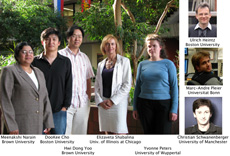
These primary analyzers worked with their colleagues to produce DZero's most precise measurements of top quark properties.
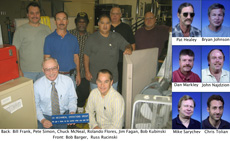
The DZero mechanical operations team maintains the mechanical infrastructure of the experiment, yielding stable and efficient data collection. This is essential for the success of all DZero analyses.
Result of the Week Archive
|
New hires
New hires Oct. 8-16:
- Timothy Trout - FESS - construction field specialist
- Stephanie Schuler - PPD - administrative support assistant
- Rosette Mace - FI - accounting associate
- Amanda Petersen - WDRS - international services
- Pasquale Blasi - FCPA - guest scientist
|
|
Have a safe day!
Wilson Hall exterior restoration
work through mid-December
Wilson Hall will undergo concrete repair, power washing and concrete sealing beginning today and lasting through mid-December, as weather permits. This phase of the Wilson Hall five-year inspection and repair cycle will affect the east side of Wilson Hall only. Noisy work will be limited to early morning hours before 9 a.m. Parking and pedestrian traffic will be limited along the east side, depending on which building bays are being serviced. Motorcycle and bicycle parking will be temporarily moved from the east to the west side lot starting Oct. 29. For more information, contact Russ Alber (630) 840-2501 or ralber@fnal.gov.
Wilson Hall east parking
lot closed Oct. 22-26
The Wilson Hall east parking lot will be closed Oct. 22-26 to accomodate a tent for the
ALCPG07 meeting. Handicapped parking in the east lot will remain
available. The Fermilab taxi will pick up passengers on the west side of the
building.
Project X physics workshop Nov. 16-17
Fermilab will host a user's workshop Nov. 16-17 to discuss the physics of Project X.
The group will meet at 8:30 a.m. Friday, Nov. 16, in One West. A wine and cheese talk by Michelangelo Mangano runs from 4 to 5:30 p.m. The Saturday session will be partly in One West, but also will include parallel sessions in different rooms. Streaming video of the sessions will be provided.
The agenda can be found here.
You should register if you plan to attend or watch the streaming video. Online registration is available.
Fermilab cafe to close early Oct. 22-23
On Oct. 22 and 23, the Fermilab cafe will close at 3 p.m. in order to
prepare for the ALCPG07 meeting activities.
Fright Fest discounted tickets
Buy tickets now for Fermilab Fright Fest Days at Six Flags Oct. 19-21. Tickets are $25.25 each and available at the Recreation Office, WH15W. If you cannot attend the Fermilab days, ask about other special savings for other weekends.
Additional Activities |
|